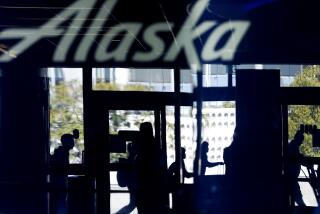Passengers and airlines under pressure
The nation’s air travelers may be wondering whether last week’s three airline shutdowns signal more trouble ahead. But a bigger concern this spring may be the likelihood of more flight delays, jammed planes and even higher ticket prices.
With rising fuel costs, fewer planes in the sky and heightened safety concerns with aging aircraft, travelers can expect flights to be more expensive, crowded and late, giving passengers more reasons not to fly this year.
“It sure is a lot more expensive to fly these days,” said Barry Trupp, a farmer who lives outside of Denver and was flying back home from Los Angeles International Airport on Sunday. “I wonder if a lot more people will take driving vacations.”
If fewer people fly, struggling airlines may not be able to manage the high fuel costs and decide to call it quits, following last week’s demise of Skybus, ATA Airlines Inc. and Aloha Airlines, analysts said.
The three regional carriers had different reasons for ceasing operations but all of them said high jet fuel costs helped push them over the edge. ATA, for instance, abruptly grounded all of its flights Thursday after it lost a major military contract for charter flights. Aloha cited “predatory pricing” from a new competitor, Mesa Air Group Inc.’s Go airline for flights between the Hawaiian islands, as a major reason for ceasing operations March 31.
What airline will be the next to shut down? “That’s the $64,000 question,” said George Hamlin, managing director for ACA Associates, a New York aviation consulting firm. With a credit crunch that has all but eliminated “sugar daddies to bail out airlines, the word to the wise is that weaker carriers will drop off first.”
Analysts said regional carriers ExpressJet, Frontier and recent start-up Virgin America were considered somewhat vulnerable if fuel prices continued to hover at record levels. All three have service at Southern California airports.
ExpressJet, which last year launched service from Ontario Airport, recently began flights from Long Beach Airport and has been trying to lure budget-conscious travelers with low fares. Virgin America, a carrier started by British billionaire Richard Branson, has been adding flights at LAX to destinations such as Seattle and Washington, D.C. Frontier is facing intense competition from much larger carriers Southwest Airlines and United Airlines for flights to Colorado and elsewhere.
Although major carriers such as American Airlines and United are not facing dire financial problems, they are also feeling the pinch. And when the big airlines feel the pinch, so will millions of passengers and their pocketbooks.
American said Friday that it was freezing the hiring of management and support staffers as it struggled with high fuel costs. The nation’s largest airline said it expected to spend $9.3 billion on fuel this year, up nearly 40% from last year.
In all, the Air Transport Assn. estimates that U.S. airlines will spend an additional $14 billion on fuel this year, shattering the record set last year.
“It’s no secret that the entire industry, including us, has been struggling to contain costs, mainly the cost of fuel,” American Airlines spokesman Andy Backover said.
Northwest Airlines, the nation’s fifth-largest, also said it was planning to freeze the hiring of pilots and flight attendants as it cut its domestic schedule by about 5% starting after the peak summer travel season.
The big airlines are also adding fees and other restrictions that are expected to make flying more expensive for passengers. Northwest, following on the lead of other big carriers, is extending the minimum stay requirements for some cheaper fares from one or two nights to two or three nights.
And Continental Airlines last week became the latest carrier to announce that it would begin charging $25 for a second checked baggage for those flying in coach, starting May 5.
On top of fuel costs, the airlines are also facing increased regulatory scrutiny and have had to temporarily ground planes to make sure they met safety inspection requirements.
Grounding planes, even for a few hours, is costly because they don’t generate any passenger revenue when airlines need paying customers more than ever. Allegations of lax safety inspections led to congressional hearings last week and calls for stricter compliance.
Analysts said U.S. airlines had already squeezed as much cost out of their operations as possible since the 2001 terrorist attacks led to an air travel slump.
More than 20 U.S. airlines filed for Bankruptcy Court protection from 2001 to 2006, including four of the six largest network carriers.
United, during its bankruptcy reorganization, slashed $7 billion in annual expenses and grounded 100 planes. The Chicago-based airline emerged from bankruptcy in 2006.
But the restructuring that helped the airline cut costs and run more efficiently “will not be sufficient, with oil at $100 plus a barrel, to maintain the industry’s short-lived period of profitability,” said Glenn F. Tilton, United’s chief executive, in a speech to the U.S. Chamber of Commerce last week.
After five years of losses, the U.S. airline industry posted its first full-year of profits last year.
Although cost cuts have kept airlines financially viable, they have been painful for passengers, according to a new study to be unveiled today.
Complaints rose 60% last year as on-time arrivals dropped for the fifth straight year, according to an airline quality study compiled by the Aviation Institute at the University of Nebraska and by Wichita State University.
“Americans have to do something about the airline business because it’s embarrassing,” San Diego resident Christine Ess said as she was checking in for a flight from Los Angeles to Toronto. “The service is dreadful and the safety is worrisome.”
But Terry Trippler, a long-time Minneapolis travel consultant who runs travel website Tripplertravel.com, said that demand for vacation trips continued to be strong despite higher airfares and longer delays.
“It’s absolutely amazing how resilient travel is these days,” Trippler said. “They may temporarily put a wooden block under a broken couch but they are still going to take a vacation.”
Atlanta graduate student Priti Taparia, who was at LAX waiting for a flight back home, said she had seen ticket prices rise but hadn’t let that stop her from traveling.
Recently she paid $500 for a flight to Miami, more than double what she’d normally pay for that route. “I’d prefer cheaper, but I’ll still pay more if the trip is important.”
peter.pae@latimes.com ken.bensinger@
latimes.com
More to Read
Sign up for The Wild
We’ll help you find the best places to hike, bike and run, as well as the perfect silent spots for meditation and yoga.
You may occasionally receive promotional content from the Los Angeles Times.






